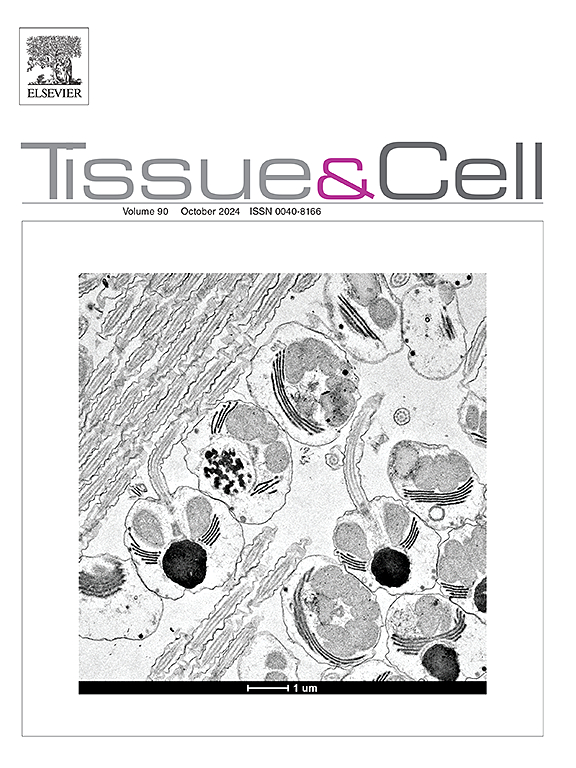成人嗅脚的解剖、组织学和超微结构:血管和淀粉体的评估。
IF 2.7
4区 生物学
Q1 ANATOMY & MORPHOLOGY
引用次数: 0
摘要
哺乳动物嗅觉系统负责处理环境化学刺激,包括嗅上皮、嗅球、嗅脚和嗅皮质等几个结构。尽管OP在嗅觉信息传导中发挥了关键作用,但它仍未得到充分研究。在这项工作中,使用光学、共聚焦和电子显微镜检查了6例年龄在37-84岁的人类OP标本的解剖、组织学和超微结构。在冠状切片上鉴定出三个同心层:外层(EL)、轴突层(AL)和内层(IL)。免疫组化显示神经元和神经胶质细胞分布于整个op,观察到两种神经元形态:颗粒细胞和较大的锥体细胞,后者与前嗅核的投射神经元相关。星形胶质细胞分布均匀,呈放射状分布。少突胶质细胞主要分布于AL,血管沿OP均匀分布,平均管腔面积为82.9 µm²,密度为1.26 %,IL明显增加。淀粉体(CA)丰富,平均大小为49.3 µm²,密度为3.23 %。CA聚集在bv附近,特别是在组织边缘,大小和密度随年龄增长而增加。值得注意的是,CA与星形胶质细胞有很强的相关性。本研究首次提供了关于人类OP内部组织的详细定性和定量数据,这可能有助于更好地理解一些神经病理疾病的病理生理。本文章由计算机程序翻译,如有差异,请以英文原文为准。
Anatomy, histology and ultrastructure of the adult human olfactory peduncle: Blood vessel and corpora amylacea assessment
The mammalian olfactory system is responsible for processing environmental chemical stimuli and comprises several structures, including the olfactory epithelium, olfactory bulb, olfactory peduncle (OP), and olfactory cortices. Despite the critical role played by the OP in the conduction of olfactory information, it has remained understudied. In this work, optical, confocal, and electron microscopy were employed to examine the anatomy, histology, and ultrastructure of six human OP specimens (ages 37–84 years). Three concentric layers were identified in coronal sections: the external layer (EL), the axonal layer (AL), and the internal layer (IL). Immunohistochemistry revealed the distribution of neurons and glial cells throughout the OP. Two neuronal morphologies were observed: granule cells and larger pyramidal cells, the latter associated with projection neurons of the anterior olfactory nucleus. Astrocytes were uniformly distributed with a more radial morphology in the EL. Oligodendrocytes were mainly located in the AL. Blood vessels (BVs) were evenly distributed along the OP, with a mean luminal area of 82.9 µm² and a density of 1.26 %, with a significant increase in the IL. Corpora amylacea (CA) were abundant, with an average size of 49.3 µm² and a density of 3.23 %. CA clustered near BVs, particularly at tissue edges, with both size and density increasing with age. Notably, CA showed strong associations with astrocytes. This study provides the first detailed qualitative and quantitative data on the internal organization of the human OP, which may contribute to a better understanding of the pathophysiology of some neuropathological disorders.
求助全文
通过发布文献求助,成功后即可免费获取论文全文。
去求助
来源期刊

Tissue & cell
医学-解剖学与形态学
CiteScore
3.90
自引率
0.00%
发文量
234
期刊介绍:
Tissue and Cell is devoted to original research on the organization of cells, subcellular and extracellular components at all levels, including the grouping and interrelations of cells in tissues and organs. The journal encourages submission of ultrastructural studies that provide novel insights into structure, function and physiology of cells and tissues, in health and disease. Bioengineering and stem cells studies focused on the description of morphological and/or histological data are also welcomed.
Studies investigating the effect of compounds and/or substances on structure of cells and tissues are generally outside the scope of this journal. For consideration, studies should contain a clear rationale on the use of (a) given substance(s), have a compelling morphological and structural focus and present novel incremental findings from previous literature.
 求助内容:
求助内容: 应助结果提醒方式:
应助结果提醒方式:


